 |
| July 23, 2019 | Volume 15 Issue 28 |
Designfax weekly eMagazine
Archives
Partners
Manufacturing Center
Product Spotlight
Modern Applications News
Metalworking Ideas For
Today's Job Shops
Tooling and Production
Strategies for large
metalworking plants
50 Years Ago: Apollo 11 launch and Moon landing
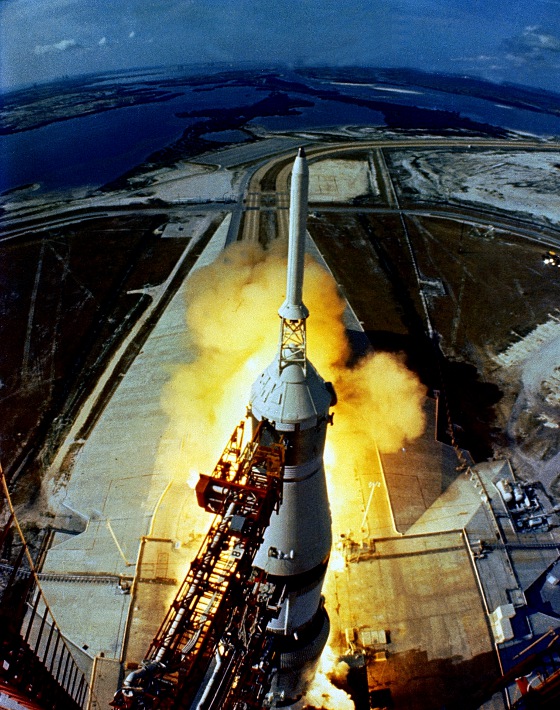
The huge, 363-foot-tall Saturn V rocket with the Apollo 11 space vehicle launched at 9:32 a.m. EDT on July 16, 1969, from Pad A, Launch Complex 39 at NASA's Kennedy Space Center in Florida. This view of liftoff was taken by a camera mounted on the mobile launch tower. [Credits: NASA]
By John Uri, NASA Johnson Space Center
[Countdown Series: 50th anniversary of Apollo 11]
An estimated 1 million people gathered on the beaches of central Florida to witness first-hand the launch of Apollo 11, while more than 500 million people around the world watched the event live on television.
Officially named as a crew just six months earlier, Commander Neil A. Armstrong, Lunar Module Pilot (LMP) Edwin E. "Buzz" Aldrin, and Command Module Pilot (CMP) Michael Collins were prepared to undertake the historic mission. Previous Apollo crews had tested the spacecraft in Earth orbit and around the Moon, and only two months earlier, Apollo 10 had completed a dress rehearsal to sort out all the unknowns for the lunar landing. Now it was time to attempt the landing itself.
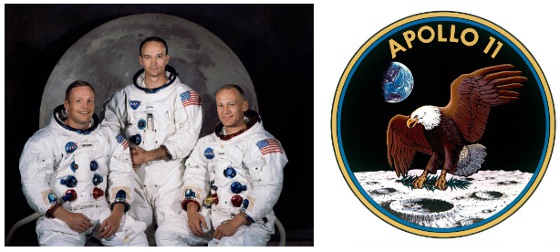
Left: Apollo 11 crew of (left to right) Armstrong, Collins, and Aldrin. Right: Apollo 11 crew patch.
The astronauts' day on July 16, 1969, began with a 4 AM wake-up call from Chief of the Astronaut Office Donald K. "Deke" Slayton. After the traditional pre-launch breakfast with Slayton and back-up CMP William A. Anders, the crewmembers donned their spacesuits and took the Astrovan to Kennedy Space Center's (KSC) Launch Pad 39A. Workers in the White Room assisted them into their seats in the Command Module (CM) Columbia, Armstrong into the left-hand couch, Collins into the right, and finally Aldrin into the middle. After the pad workers closed the hatch to the capsule, the astronauts settled in for the final two hours of the trouble-free countdown. As Armstrong noted just before liftoff, "It's been a real smooth countdown."
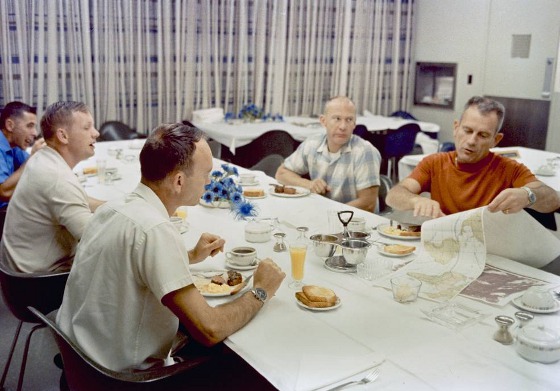
Pre-launch breakfast in crew quarters (left to right) Anders, Armstrong, Collins, Aldrin, and Slayton.
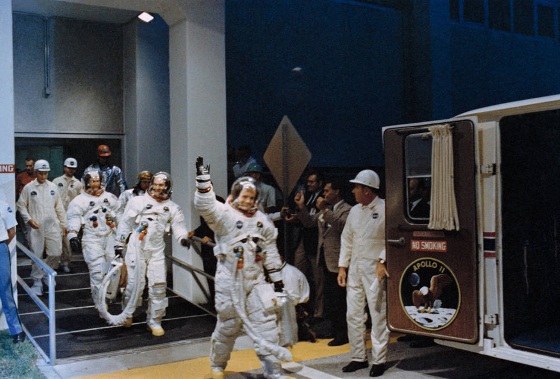
Apollo 11 astronauts (left to right) Aldrin, Collins, and Armstrong leaving crew quarters to enter the Astrovan for the ride to Launch Pad 39A.
At precisely 9:32 AM EDT, Apollo 11 lifted off from Launch Pad 39A to begin humanity's first attempt at a manned lunar landing. Engineers in KSC's Firing Room 1 who had managed the countdown handed over control of the flight to the Mission Control Center (MCC) at the Manned Spacecraft Center (MSC), now the Johnson Space Center in Houston, as soon as the rocket cleared the launch tower. In MCC, the Green Team led by Flight Director Clifford E. Charlesworth took over control of the mission. The Capcom, or capsule communicator, the astronaut in MCC who spoke directly with the crew during launch, was Bruce McCandless.
The three stages of the Saturn V performed flawlessly and successfully placed Apollo 11 into low Earth orbit. For the next two-and-a-half hours, as the Apollo spacecraft still attached to its S-IVB third stage orbited the Earth, the astronauts and MCC verified that all systems were functioning properly. McCandless then called up to the crew, "Apollo 11, you're go for TLI," the Trans Lunar Injection, the second burn of the third-stage engine to send them on their way to the Moon.
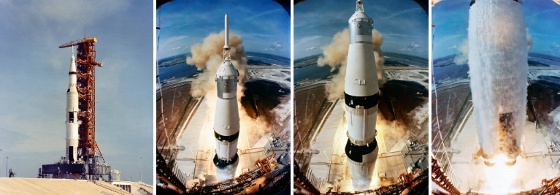
Liftoff of Apollo 11.
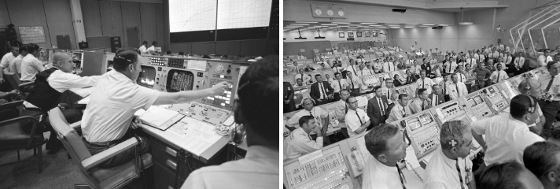
Left: Flight Director Charlesworth in MCC during Apollo 11 launch. Right: Engineers in KSC's Firing Room watch the launch after Apollo 11 cleared the launch tower.
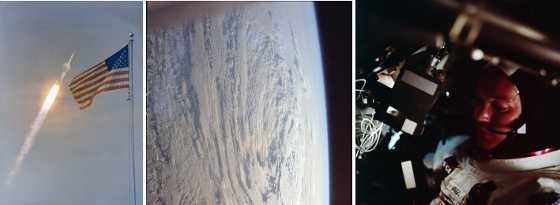
Left: A ring of condensation forms around the Saturn V rocket as it compresses the air around it during the launch of Apollo 11, framed with an American flag in the foreground. Middle: A view of a low-pressure system taken during Apollo 11's first orbit around the Earth. Right: Collins inside the CM during its first orbit around the Earth.
Two hours and 44 minutes after liftoff, the third-stage engine ignited for the six-minute TLI burn, increasing the spacecraft's velocity to more than 24,000 miles per hour, enough to escape Earth's gravity. Armstrong called down to the ground after the burn, "That Saturn gave us a magnificent ride. It was beautiful."
A little over three hours after launch, and already more than 3,000 miles from Earth, the Command and Service Module (CSM) separated from the spent third stage to begin the transposition and docking maneuver. Collins flew the CSM Columbia out to a distance of about 100 feet and turned it around to face the now exposed LM Eagle still tucked into the top of the third stage. He slowly guided Columbia to a docking with Eagle, then extracted it from the third stage which was sent on a path past the Moon and into orbit around the Sun. During the maneuver, the spacecraft had traveled another 3,000 miles away from Earth.
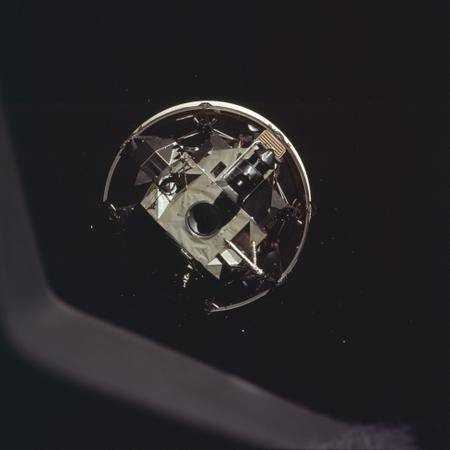
The LM Eagle still in the third stage during the transposition and docking maneuver, as seen from the CM Columbia.
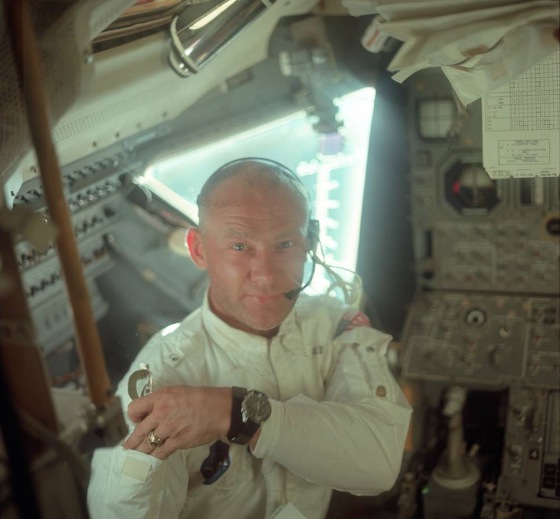
Aldrin inside the LM Eagle during the first activation, on the way to the Moon.
During the rest of their first day in space, MCC informed the crew that because the launch and TLI had been so precise, the planned first midcourse correction would not be needed. The astronauts were finally able to remove the spacesuits they'd been wearing since before launch.
Armstrong called down with birthday wishes for the state of California (200 years old) and for Dr. George E. Mueller, NASA Associate Administrator for Manned Space Flight (stated as "not that old"). In MCC, Flight Director Eugene F. Kranz's White Team of controllers took over, with astronaut Charles M. Duke as the new Capcom. The astronauts provided a pleasant surprise with an unscheduled 16-minute color television broadcast, treating viewers on Earth with spectacular scenes of their home planet. They then placed their spacecraft in the Passive Thermal Control (PTC) or barbecue mode, rotating at three revolutions per hour, to evenly distribute temperature extremes. Finally, about 13 hours after launch and a very long day, the crew began its first sleep period, with Apollo 11 about 63,000 miles from Earth.
Overnight, Flight Director Glynn S. Lunney's Black Team of controllers, with astronaut Ronald E. Evans as Capcom, watched over the spacecraft's systems. By the time the astronauts awoke, now almost 110,000 miles from Earth, Charlesworth's Green Team was back on console. Capcom McCandless provided a morning news update to the crew, including a status of the Soviet Luna 15 robotic spacecraft that had launched three days before Apollo 11 and was still on its way to the Moon.
The crew conducted the only midcourse correction needed during the coast to the Moon, a three-second burn of the Service Propulsion System (SPS) engine to lower the closest point to the Moon from 200 miles to 69 miles. McCandless informed the astronauts that Luna 15 had entered an elliptical orbit around the Moon, but that its objectives were still not clear.

Photographs taken from Apollo 11 show the receding Earth (left to right) shortly after the transposition and docking maneuver, from 113,000 miles, and from 144,300 miles.
The crew conducted a scheduled TV broadcast from about 150,000 miles, showing views of a much smaller Earth with Armstrong providing a detailed description of the planet. He then turned the camera inside the cabin for views of the astronauts and showing viewers their food pantry, concluding with filming the Apollo 11 mission patch on their flight suits. The broadcast lasted 35 minutes. The crew soon after settled down for its second night's sleep in space, which MCC extended since another midcourse correction the next morning was not needed as their trajectory remained very precise.
In Houston, astronaut Frank Borman and Christopher C. Kraft, Director of Flight Crew Operations, held a press conference about Luna 15. NASA managers were concerned that with Luna 15 now in orbit around the Moon and its objectives still not clear, it might interfere in some way with Apollo 11. Borman had visited Moscow earlier in July and met with Academician Mstislav V. Keldysh, President of the Soviet Academy of Sciences. Taking advantage of this new acquaintance, Borman telephoned Keldysh and expressed NASA's concerns. Keldysh assured Borman that Luna 15 would not interfere with Apollo 11, and in an unprecedented action in American-Soviet space relations he telegraphed Luna 15's precise orbital parameters to Borman. The Soviets didn't divulge Luna 15's true intentions, stating only that it would stay in lunar orbit for two days.
The major activity for Apollo 11's third day in space was the first activation and inspection of the LM Eagle, which the crew televised to the ground from about 201,000 miles away. Armstrong described the status of the docking mechanism, "Mike must have done a smooth job in that docking. There isn't a dent or a mark on the probe" -- a compliment of Collins' excellent piloting skills. When they opened the hatch to Eagle, the lights came on automatically, prompting Capcom Duke to say, "How about that. Just like the refrigerator."
Aldrin floated into the LM, taking the TV camera with him, and provided viewers with an excellent tour of all of its systems, as well as the astronauts' spacesuit helmet visors and backpacks. The broadcast lasted one hour and 36 minutes, after which Aldrin and Armstrong returned to Columbia and closed the hatches. Soon after, Apollo 11 passed into the Moon's gravitational sphere of influence, 214,086 miles from Earth and 38,929 miles from the Moon. The crew settled down for its third sleep period of the flight.
While the crew slept, MCC decided that a planned midcourse correction that day would also not be required, and they extended the crew's rest. Shortly after they woke for their fourth day in space, Apollo 11 crossed into the Moon's shadow and they could observe the solar corona. They could see the Moon's surface lit by Earthshine, and for the first time they could see stars and constellations clearly.
Capcom astronaut and back-up Apollo 11 LMP Fred W. Haise read up the morning news to the crew. An item of interest was that in its reporting of the mission, the Soviet newspaper Pravda called Armstrong the "Czar of The Ship." The Soviet press was indicating that Luna 15 would accomplish everything that all previous Luna spacecraft had done, the first public hint that it might be trying to return samples from the Moon. Armstrong provided the following description of the Moon, which the astronauts were seeing for the first time:
"The view of the Moon that we've been having recently is really spectacular. It fills about three-quarters of the hatch window, and of course, we can see the entire circumference, even though part of it is in complete shadow and part of it's in Earthshine. It's a view worth the price of the trip."

Three views of the lunar far side. Left: Crater Glazenap. Middle: Crater King. Right: Looking toward the Moon's limb over the rim of Crater Mendeleev.
Shortly after, as Apollo 8 and 10 had done before, Apollo 11 sailed behind the Moon and all contact with Earth was cut off. Eight minutes later, they fired the SPS engine for the six-minute Lunar Orbit Insertion-1 (LOI-1) burn, and Apollo 11 entered into an elliptical lunar orbit.
As Apollo 11 came around from the back side of the Moon, the crewmembers saw their first Earthrise and Aldrin reported their status to MCC, "The LOI-1 burn just nominal as all getout, and everything's looking good." A few minutes later, the astronauts got their first view of the approach to their landing site in the Sea of Tranquility, which was still in darkness. By the time of the landing the next day, the Sun would have risen at the landing site, the low angle illumination providing optimal lighting for the landing. Of the approach Armstrong commented, "It looks very much like the pictures, but like the difference between watching a real football game and one on TV. There's no substitute for actually being here."
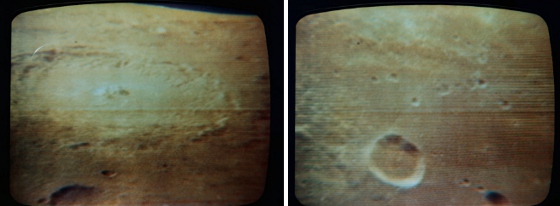
Two views of the Moon from Apollo 11's first TV broadcast from lunar orbit. Left: The Crater Langrenus. Right: The Mare Fecunditatis.
During their second lunar orbit, the crew televised views of the Moon across much of the near side. At the end of that revolution, and once again behind the Moon, they fired the SPS engine for the 17-second LOI-2 burn to circularize their orbit. Armstrong and Aldrin entered the LM Eagle for the second time to begin activation and transfer of equipment such as cameras. Aldrin reported that he could see the entire landing area as they flew over it. They returned to Columbia, and the entire crew settled down for its first sleep period in lunar orbit. It was also their final night before attempting the first Moon landing the next day.
MEN LAND ON THE MOON!!
Words such as these were emblazoned in dozens of languages on the front page of newspapers around the world, echoing the first part of President John F. Kennedy's bold challenge to the nation, made more than eight years earlier: to land a man on the Moon. That part was successfully accomplished on July 20, 1969. The second part of the challenge, the safe return to Earth, would have to wait four more days.
Apollo 11 astronauts Neil A. Armstrong, Edwin E. "Buzz" Aldrin, and Michael Collins awoke to start their fifth day in space at the end of their ninth revolution around the Moon. In Mission Control at the Manned Spacecraft Center, Eugene F. Kranz's White Team of controllers arrived on console, with astronaut Charles M. Duke serving as Capcom. After a quick breakfast, Aldrin and Armstrong began re-activating the Lunar Module (LM) Eagle, including deploying its landing gear, and donned their pressure suits. Near the end of the 12th orbit around the Moon, Duke radioed up to Apollo 11 that they were GO to undock.
The event took place behind the Moon during the start of their 13th revolution, with the astronauts filming each other's spacecraft as they began their independent flights. After they reappeared from behind the Moon, Armstrong radioed their status to MCC saying, "The Eagle has wings." Collins in the Command Module (CM) Columbia observed, "I think you've got a fine-looking flying machine there, Eagle, despite the fact you're upside down," prompting Armstrong to reply, "Somebody's upside down."
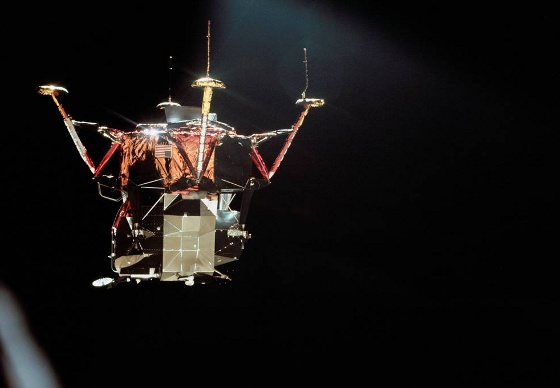
Eagle shortly after undocking.
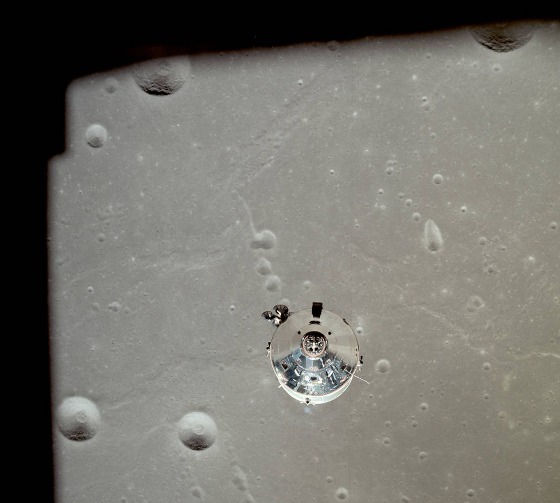
Columbia shortly after undocking.
From this point on, it was time to get down to business as events happened rather quickly. As the Moon landing attempt was less than an hour away, the viewing gallery in Mission Control was filling with NASA managers from across the agency, and many astronauts were present in the control room itself to witness the historic event. Later during the 13th orbit, about 10 minutes before Apollo 11 disappeared again behind the Moon, Duke radioed up the GO for Descent Orbit Insertion (DOI).
The DOI burn, a 30-second firing of the LM's Descent Propulsion System (DPS) engine, took place behind the Moon, lowering the low point of Eagle's orbit to about 50,000 feet, as close as Apollo 10 got to the Moon's surface. The two craft now flying separately reappeared from behind the Moon on their 14th orbit. Duke radioed up the GO for Powered Descent Initiation (PDI), the beginning of the landing maneuver. Eagle's antenna repeatedly lost lock on the Earth, so Mission Control had to communicate with Eagle through Collins in Columbia until reliable radio links were re-established.
At the beginning of PDI, the LM's DPS engine ran at 10% thrust for 26 seconds for a smooth initial deceleration before increasing to full thrust. Eagle was flying engine first and windows facing down toward the Moon's surface and was about 300 miles east of the landing site in the Sea of Tranquility. Eagle's attitude allowed Armstrong to track landmarks as they passed over them against the predicted times.
Based on Eagle passing landmarks about two to three seconds early, Armstrong predicted that they would land about three miles further downrange than planned -- and he was proved correct. At an altitude of 40,000 feet, Armstrong maneuvered Eagle to a windows-up orientation. This was in preparation for the pitch-over maneuver, which placed the windows facing forward in the direction of flight, and also positioned the landing radar so it could see the lunar surface.
At about 33,000-foot altitude, Armstrong and Aldrin were surprised by the first 1202 program alarm, which they had not seen in simulations. After a few seconds of analysis in MCC, Duke gave them a GO to proceed. The alarm simply meant the computer was overloaded with too much data and couldn't process it all, but controllers felt confident they could proceed with the landing. When a second 1202 alarm sounded less than a minute later, Duke once again gave the GO to proceed.
Eagle maneuvered to a more vertical orientation for the final phase of the descent. At about 5,000 feet and descending about 100 feet per second, Armstrong took over manual control of Eagle's attitude. As they passed through 3,000 feet with their descent rate slowed to 70 feet/second, Duke gave them the GO for landing, and they received the 1201 program alarm. Once again, Duke gave them the GO to proceed. Another 1202 flashed at about 1,000 feet altitude. At about 600 feet, noticing Eagle's computer was taking them down into a boulder-strewn area near West Crater, Armstrong took over manual control of the descent. He pitched Eagle to a more vertical orientation, which slowed the descent, and decided to overfly the rough area and look for smoother terrain to land on.
Armstrong found and flew to a clearer spot for landing, and Aldrin called out that he saw the LM's shadow on the Moon. Armstrong picked his final spot, about 60 meters east of Little West Crater. At about 100 feet, the fuel-quantity warning light came on, indicating only 5% fuel remaining, giving Armstrong about 90 seconds of hover time left. With 60 seconds of fuel remaining, they were down to about 40 feet and the descent engine was kicking up dust from the surface, increasingly obscuring Armstrong's visibility.
At precisely 3:17:40 PM Houston time on July 20, 1969, Aldrin called out "Contact light," indicating that at least one of the three 67-inch probes hanging from the bottom of three of the LM's footpads had made contact with the Moon. Eagle drifted to the left when three seconds later, Armstrong called out, "Shutdown," followed by Aldrin's, "Okay. Engine stop," indicating the DPS engine was shut off.
They were on the Moon.
In Houston, Duke noted via telemetry that the engine had shut down, and called to Armstrong and Aldrin, "We copy you down, Eagle." Armstrong responded with the historic words, "Houston, Tranquility Base here. The Eagle has landed."

Left: In Mission Control during the descent to the Moon (left to right) Capcom Duke, and Apollo 11 crewmembers James A. Lovell and Fred W. Haise. Right: In Mission Control during the Moon landing (left to right) Apollo 12 prime crewmembers Charles Conrad and Alan L. Bean and their backups David R. Scott and James B. Irwin.
It should be noted that for everyone on Earth, the first Moon landing was purely an audio experience. Controllers in MCC had the added benefit of telemetry from the spacecraft, but there was no live television of the landing. A 16-mm silent film camera mounted in the right-hand (Aldrin's) window recorded the event, but was not available for viewing until it was returned to Earth and developed. An annotated video of the landing was prepared from this film (courtesy of Apollo Flight Journal), and synchronized with space-to-ground communications, several loops in Mission Control, and video clips from MCC.

Three views of the lunar surface as Armstrong and Aldrin saw it shortly after landing, taken through Armstrong's left-side LM window (left), and through Aldrin's right-side window (middle and right).
After a few minutes, Aldrin provided the first verbal description of their surroundings, including the types and sizes of rocks and the general color of the surface. Duke radioed to them, "Be advised there are lots of smiling faces in this room and all over the world," prompting Armstrong's response, "Well, there are two of them up here."
Armstrong reported that neither he nor Aldrin had any trouble adjusting to the one-sixth gravity on the lunar surface. He continued with a more detailed description of their view out the forward windows.
As they continued their post-landing activities, Armstrong called MCC to advise that he and Aldrin would like to forego the planned rest period before their Extra-Vehicular Activity (EVA), or spacewalk, and MCC concurred with their proposal. Aldrin made the following request to anyone who might be listening, "I'd like to take this opportunity to ask every person listening in, whoever and wherever they may be, to pause for a moment and contemplate the events of the past few hours and to give thanks in his or her own way." He then proceeded to take communion with a chalice and consecrated wine he brought along for the occasion.
He and Armstrong then began preparations for their historic spacewalk, including donning their Portable Life Support Systems (PLSS), the backpacks that provided oxygen, removed carbon dioxide, and enabled communications. The Green Team of flight controllers led by Clifford E. Charlesworth, with Bruce McCandless serving as Capcom, took their positions in Mission Control to help Armstrong and Aldrin prepare for and execute their EVA. They reconfigured Eagle's cabin for depressurization, donned their helmets, visors, and gloves, and then opened the valve that vented the cabin.
Aldrin opened Eagle's forward hatch, which swung inward toward him, giving Armstrong access to the outside front porch. Aldrin added, "About ready to go down and get some Moon rock?" He helped Armstrong navigate through the narrow confines of Eagle's hatch and onto the front porch. Once on the ladder, Armstrong pulled a lanyard that released the Modularized Equipment Stowage Assembly (MESA) on the side of Eagle's Descent Stage, on which was mounted a black and white TV camera, allowing hundreds of millions of viewers on Earth to see him descend the ladder down to the landing leg's footpad.
As a precaution, he practiced the three-foot jump back up to the ladder's first rung, made easier in the one-sixth lunar gravity. Once back down on the footpad, Armstrong described that the footpads had only sunk one or two inches into the lunar dust, which he noted was fine-grained, almost powdery.
Armstrong announced, "I'm going to step off the LM now." And at 9:56 PM Houston time he did just that, firmly planting his left foot onto the lunar surface, proclaiming, "That's one small step for a man, one giant leap for mankind."
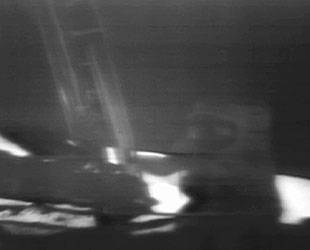
View 1 of Armstrong taking the first step on the lunar surface is a still image from the live TV downlink.
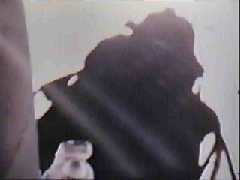
View 2 of Armstrong taking the first step on the lunar surface is a still image from the 16-mm camera mounted in Eagle's window.
VIDEO: Moon landing. [Credits: National Archives]
VIDEO: Footage from the Apollo 11 moonwalk that was partially restored in 2009. [Credits: NASA]
After taking his first tentative steps on the lunar surface, Armstrong began his first tasks of the spacewalk, including receiving the Hasselblad still camera from Aldrin via a lanyard and pulley system, using it to take the first photographs of Eagle to document how it fared during the landing as well as of their surroundings, and collecting the contingency sample of lunar material in case they had to make an emergency departure. A few minutes later, Aldrin began his descent to the surface, commenting on the way out of the cabin, "Now I want to ... partially close the hatch. Making sure not to lock it on my way out." This prompted a laugh from Armstrong who commented, "A particularly good thought."

Sequence of images of Aldrin climbing down Eagle's ladder to join Armstrong on the surface.
Once Aldrin was on the surface, he and Armstrong unveiled the commemorative plaque that was mounted on the landing leg and read the words that were inscribed on it, "Here men from the planet Earth first set foot upon the Moon, July 1969 A.D. We came in peace for all mankind." The plaque bore the signatures of the Apollo 11 astronauts as well as of President Richard M. Nixon.
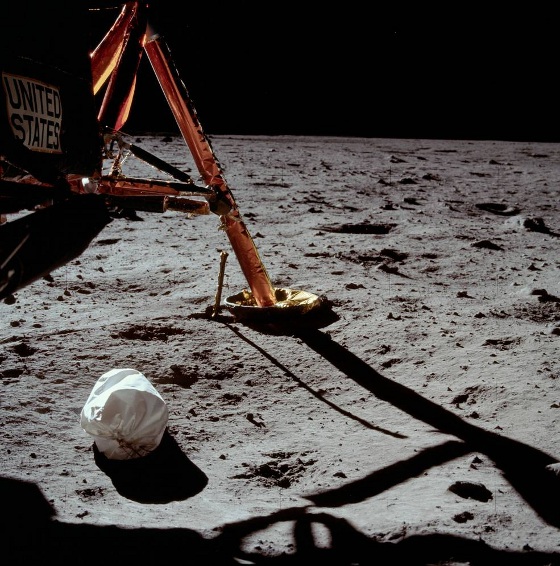
First photograph from the surface EVA, showing a jettison bag and a gouge left in the lunar soil by the landing probe as Eagle drifted just before touchdown.
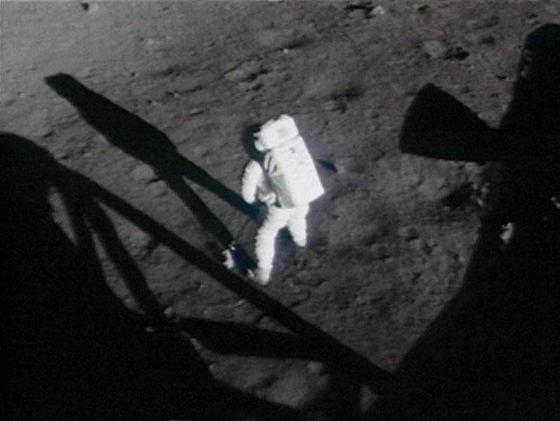
Still from the 16-mm film of Armstrong collecting the contingency sample.
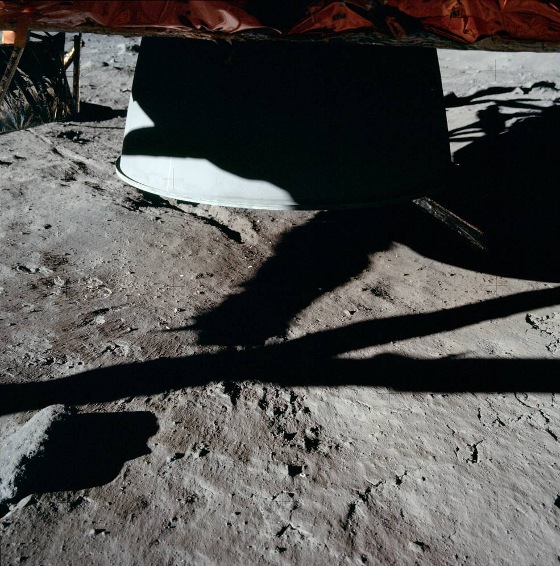
View of Eagle's Descent Stage engine bell, also showing a gouge in the soil by another landing probe.
Armstrong then removed the TV camera from the MESA, carried it about 60 feet from the LM, and mounted it on a tripod so the world audience could watch their subsequent activities. Closer to the LM, Aldrin was setting up the Solar Wind Collector (SWC) experiment, a sheet of aluminum that was exposed to the Sun for 77 minutes to collect ions in the solar wind. Near the end of the EVA, Aldrin rolled up the foil and stowed it for return to Earth for analysis by scientists.
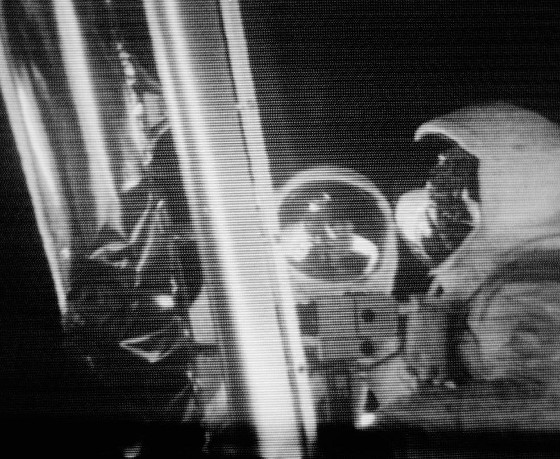
Aldrin (left) and Armstrong reading the plaque mounted on Eagle's forward landing leg strut.
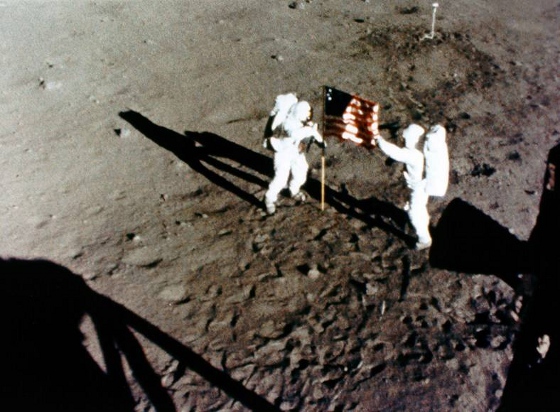
Still from 16-mm film of Armstrong (left) and Aldrin setting up the American flag.
Their next task was to remove the Lunar Flag Assembly attached to Eagle's ladder and set up the American flag about 20 feet from the LM. Because in the vacuum on the Moon there is no way for the flag to stay unfurled, a telescoping horizontal metal rod was inserted along the top of the 3-by-5-foot nylon flag. During the deployment, this metal rod did not extend all the way and left the edge of the flag somewhat wrinkled, giving it the appearance of waving in a non-existent lunar breeze.
Aldrin began to experiment with different types of locomotion in the one-sixth gravity when Capcom McCandless requested that both astronauts position themselves in front of the TV camera. For the next two minutes, Armstrong and Aldrin talked to President Nixon in the White House's Oval Office, who offered the nation's congratulations on their historic accomplishment.

Three views of the same scene to provide spatial perspective on the astronauts' activity. Left: A still from the live TV downlink that millions of viewers on Earth saw. Middle: Photograph of Aldrin and the U.S. flag taken by Armstrong. Right: Still from the 16-mm film taken by the automatic camera installed inside the LM on Aldrin's forward window.
The phone call concluded and Armstrong and Aldrin resumed their tasks, which included Aldrin performing soil cohesion tests by kicking the lunar surface with his boot and observing the resulting sprays of dust, which in the vacuum and one-sixth gravity on the Moon behaved differently from how they would on Earth. Armstrong returned to the MESA to retrieve the equipment for the bulk sample collection of lunar material. Aldrin picked up the Hasselblad to take photographs for the Bootprint Penetration Experiment, and took panoramic photos of the landing site, incidentally taking one of the few photographs of Armstrong on the surface as he packs the bulk sample at the MESA.
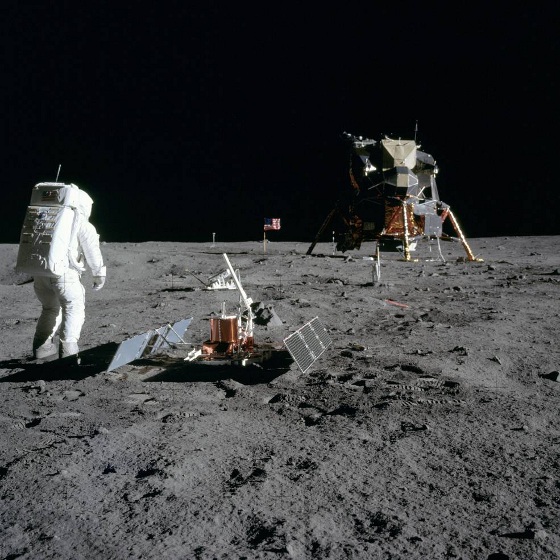
Aldrin standing next to the seismometer.
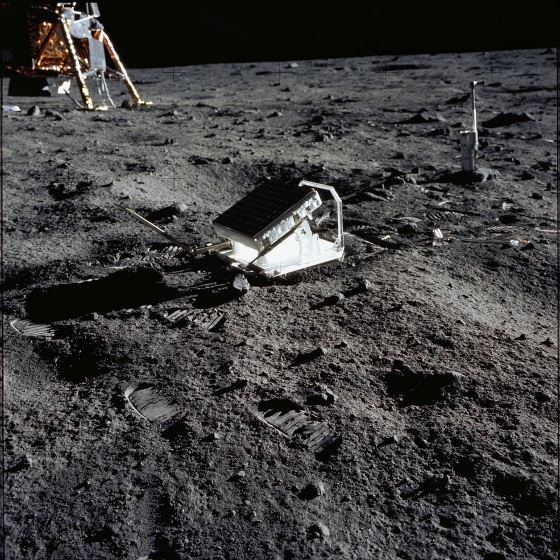
The Laser Ranging Retro-Reflector.
After more photography, Aldrin handed the camera back to Armstrong and walked to the back of the LM where the Scientific Equipment (SEQ) bay containing the Early Apollo Surface Experiment Package (EASEP) was located. The EASEP consisted of two experiments, the Passive Seismic Experiment Package (PSEP) to measure Moon quakes and the Laser Ranging Retro-Reflector (LRRR) that contained an array of mirrors to reflect a laser beam sent from Earth for precise measurements of the Earth-Moon distance. Aldrin removed the two experiments from the SEQ bay and carried them about 40 feet from the LM where he deployed the PSEP and Armstrong the LRRR.
At this point, they were running about 30 minutes behind the timeline, but their consumables were within limits so McCandless called to tell them that Mission Control had given them a 15-minute extension on the EVA. He also mentioned that scientists had activated the seismometer and it was picking up the vibrations from their footsteps.
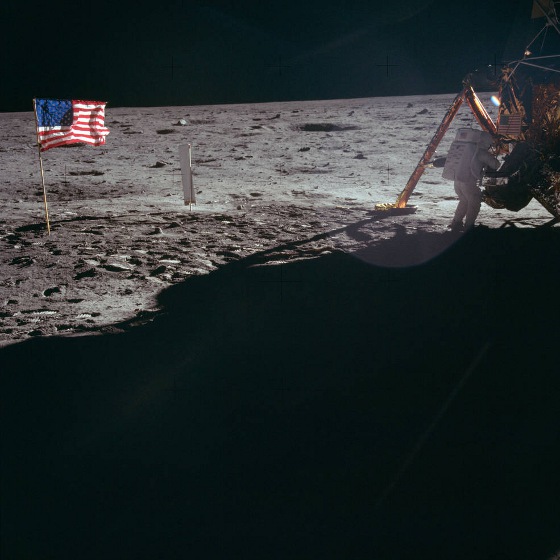
One of the few still photographs of Armstrong on the lunar surface, packing the bulk sample at the MESA; the American flag and the Solar Wind Collection experiment can be seen in the left of the photograph.
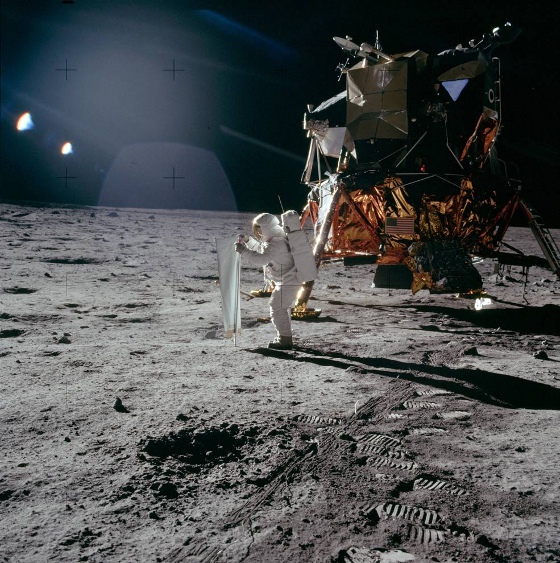
Aldrin setting up the Solar Wind Collection experiment.
Aldrin returned to the MESA to begin getting two core samples as part of the documented samples. Armstrong jogged 180 feet to Little West Crater that they had overflown during the descent and took a series of panoramic shots before jogging back to the LM to assist Aldrin with the core samples. Finishing the core samples, Aldrin rolled up the solar wind experiment. Armstrong collected about 20 rock samples weighing about 13 pounds.
And with that, it was time to finish the EVA. Armstrong and Aldrin gathered the film magazines and closed up the rock boxes. Armstrong scooped up about 13 pounds of lunar dirt as packing material for the rocks in the boxes as Aldrin climbed up the ladder and back into the LM. From there he helped Armstrong transfer the rock boxes up to the cabin using the lanyard system. A film cassette attached to the first rock box fell off and into the lunar dirt, but Armstrong retrieved and reattached it. The dirt attached to the cassette would later cause an accidental exposure to one of the employees once in the Lunar Receiving Laboratory in Houston. They hauled the second rock box up to the cabin without incident.

Photos taken after the EVA. Left: From Armstrong's window, showing the two EASEP experiments. Middle: From Aldrin's window, showing the flag and the TV camera. Right: The next morning, also from Aldrin's window, showing that the flag had changed position due to settling in the lunar soil.
Just before Armstrong headed up the ladder, he reminded Aldrin about a small package of commemorative items that they wanted to leave on the surface. Aldrin tossed it down through the hatch from inside the cabin. The items included a silicon disc etched with goodwill greetings from 73 world leaders, an Apollo 1 patch commemorating astronauts Virgil I. Grissom, Edward H. White, and Roger B. Chaffee lost in the 1967 fire, two Soviet medals honoring cosmonauts Vladimir M. Komarov killed in the Soyuz 1 accident and Yuri A. Gagarin, the first man in space killed in an airplane crash in 1968, and a small gold olive branch, identical to ones the astronauts carried to the Moon and back for their wives.
Armstrong then jumped up to the third rung of the ladder and climbed the rest of the way into the cabin. Within a minute they had the hatch closed and began repressurizing the LM. They removed their PLSS backpacks, took photographs out the windows to use up their remaining film, and ate a well-earned meal. Aldrin realized that probably while he was removing his PLSS, he broke the circuit breaker that armed the ascent stage engine, critical for their departure the next day. Fortunately, they were able to use a felt-tip pen to depress the breaker button.
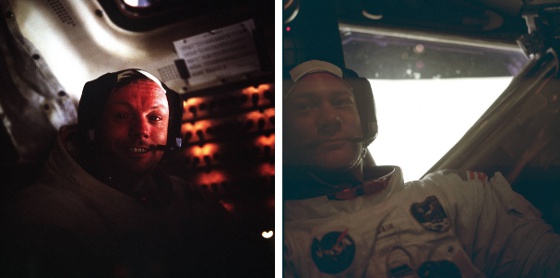
Armstrong (left) and Aldrin (right) back inside Eagle after the first spacewalk on the Moon.
Armstrong replied, "Thank you. You couldn't have enjoyed it as much as we did," and Aldrin said, "It was great."
They then depressurized the LM cabin and threw their PLSS backpacks out the hatch along with a jettison bag containing their lunar boots and other items no longer necessary. This freed up space in the cramped cabin and reduced the weight of the LM at liftoff.
Since the TV camera on the surface was still transmitting, MCC was able to observe the jettisons, and the PSEP recorded the items hitting the surface, prompting Armstrong to comment, "You can't get away with anything anymore, can you?" They then repressurized the cabin for the final time.
Their last duty before they turned in for a well-deserved, albeit restless, night's sleep, having been awake for 21 hours, was to turn off the TV camera. Aldrin curled up on the floor of the LM while Armstrong devised a hammock and slept on the ascent stage engine cover. All was quiet on the Moon, but while the astronauts slept the American flag they planted shifted position as it settled in the loose lunar soil.
The journey home
"Tranquility Base, Tranquility Base, Houston," called Capcom Ronald E. Evans on July 21, 1969, to awaken Apollo 11 astronauts Neil A. Armstrong and Edwin E. "Buzz" Aldrin after their night's sleep on the Moon. Armstrong responded with a crisp, "Good morning Houston. Tranquility Base," and Aldrin went on to describe how he had slept on the floor of the Lunar Module (LM) Eagle while Armstrong slept on the ascent engine cover with a make-shift sling to hold his legs up. Both slept with their suits, helmets, and gloves on since the temperature in the cabin was a chilly 61 degrees F. Neither man had slept too soundly, partly from the excitement of the previous day's activities, and partly from the unusual sleeping arrangements. Moreover, the Earth was shining through a navigation telescope right into Armstrong's eyes.
Evans had earlier awakened Michael Collins orbiting aboard the more spacious Command Module (CM) Columbia, who had a more restful night. All three men prepared for Eagle's liftoff from the lunar surface and rendezvous and docking with Columbia. Before departure, Armstrong and Aldrin used the 16-mm film camera to once more document their landing site through the LM's windows, showing that overnight the American flag had shifted position, apparently settling in the loose lunar soil.
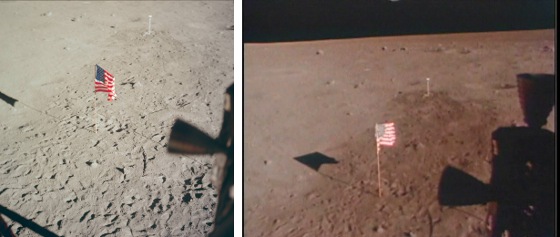
Left: Shortly after the EVA, from Aldrin's window, showing the flag and the TV camera. Right: The next morning, also from Aldrin's window, showing that the flag had changed position.
As an historical side note, as Armstrong and Aldrin were preparing for their departure from the Moon, the Soviet Luna 15 robotic spacecraft, launched three days before Apollo 11, fired its retrorocket after completing 52 lunar orbits. Signals with the craft were lost four minutes later and it is believed to have crashed in the Mare Crisium approximately 500 miles from Tranquility Base, traveling at an estimated 300 miles per hour.
After ensuring that all switches and circuit breakers were properly configured, including the one that arms the ascent stage engine that was accidentally broken by Aldrin's Portable Life Support System backpack and that had to be activated using a felt-tip pen, Evans called up, "You're cleared for takeoff." Aldrin responded, "Understand. We're number one on the runway."
After a 21-hour stay, the LM's Ascent Propulsion System (APS) engine fired precisely on time, lifting Eagle's ascent stage off the surface of the Moon, using the descent stage as a launch pad. Aldrin reported, "We're off. Look at that stuff [insulation from the decent stage] go all over the place. Look at that shadow. Beautiful." Armstrong, for the second time during the mission, radioed, "The Eagle has wings." Aldrin had installed the 16-mm film camera in his window but didn't activate it until six seconds after liftoff. They reported that the ascent stage was giving them a very smooth and quiet ride. The seven-minute APS burn placed them in a 54-by-11-mile orbit. Armstrong proclaimed, "The Eagle is back in orbit, having left Tranquility Base."

Sequence of images taken by Collins in Columbia showing Eagle's approach for docking.
An hour later, with both Eagle and Columbia behind the Moon, the LM's Reaction Control System (RCS) thrusters fired for two minutes to circularize the LM's orbit to be 58 by 53 miles. Another hour later, a one-minute RCS burn changed Eagle's orbit so it was a constant 17 miles below Columbia's. At this point, the two spacecraft were 100 miles apart with Eagle in the lower orbit catching up to Columbia. A final burn 30 minutes later put Eagle on an intercept course with Columbia. Armstrong then made a short braking burn followed by several smaller midcourse maneuvers to complete the rendezvous.
The astronauts in the two vehicles could now see each others' spacecraft, and Collins filmed Eagle's final approach. As the two spacecraft neared each other, they came around from the Moon's far side and Collins was treated to a view of Eagle back-dropped by the Earth rising over the lunar horizon. Less than four hours after lifting off from the lunar surface, and with Armstrong holding Eagle in position, Collins guided Columbia in for the docking. The two craft were reunited after spending nearly 28 hours apart.
With the hatches open between the two spacecraft, Armstrong and Aldrin began to clean up as much of the lunar dust as they could, part of the back-contamination prevention procedures, and transferred the lunar rock boxes, film cassettes, the solar wind experiment, and other items from Eagle into Columbia. Within two hours they completed all the transfers, closed the hatches for the final time and jettisoned Eagle, which remained in lunar orbit until crashing on the Moon's surface several months later.
Apollo 11 orbited the Moon for another five hours, then while behind the Moon fired the Service Propulsion System (SPS) engine for the two-and-one-half-minute Trans Earth Injection (TEI) burn at the end of Columbia's 30th lunar orbit to send the astronauts homeward. At the time of the burn, Columbia was 20 miles in front of and 1 mile below Eagle. As they rounded from behind the Moon, Armstrong called down to Capcom Charles M. Duke in Mission Control, "Time to open up the LRL doors, Charlie." He was referring to the Lunar Receiving Laboratory at the Manned Spacecraft Center, now the Johnson Space Center in Houston, where the astronauts were quarantined after their mission and the Moon rocks were first examined. Duke responded, "We got you coming home. It's well stocked." After TEI, the astronauts took their last photographs of the lunar far side and of an Earthrise.

View of the lunar far side, including the large Tsiolkovski Crater (at top center) and two of the final Earthrise photos taken by Apollo 11 after TEI.
The astronauts took a series of photographs of the receding Moon and placed their spacecraft into the Passive Thermal Control (PTC) or barbecue mode, rotating along the spacecraft's longitudinal axis three times each hour to evenly distribute temperature extremes.
Director of Flight Crew Operations Donald K. "Deke" Slayton radioed up to the crew, "This is the original CapCom. Congratulations on an outstanding job. You guys have really put on a great show up there. I think it's about time you powered down and got a little rest, however. You've had a mighty long day here. Hope you're all going to get a good sleep on the way back. I look forward to seeing you when you get back here. Don't fraternize with any of those bugs en route, except for the Hornet."
Slayton was making a humorous reference to any possible Moon germs the astronauts may be carrying back with them which necessitated the post-flight quarantine to prevent back contamination, which began as soon as they arrived aboard the prime recovery ship the USS Hornet (CVS-12) after splashdown in the Pacific Ocean. As the Apollo 11 astronauts prepared for their first sleep period of the Earthbound journey, Mission Control finally lost contact with Eagle, still in lunar orbit, as its batteries could no longer power its navigation system to point its antenna toward Earth.
Shortly after the astronauts awoke from a 10-hour rest period, they passed out of the Moon's sphere of influence and into the Earth's, and began accelerating toward their home planet. At a distance of 194,500 miles from Earth, they conducted an 11-second midcourse maneuver using the Service Module's RCS thrusters to refine their trajectory for entry into Earth's atmosphere.
The astronauts treated Earth-bound viewers with a 15-minute television broadcast, beginning with a view of the receding Moon. They turned the camera into the cabin, and Armstrong displayed the two boxes that contained the precious samples of lunar rocks and soil. They demonstrated food preparation in their spacecraft and advancements that had been made in the types of food available to them. In brief physics lessons, Aldrin demonstrated how gyroscopes work and Collins displayed the behavior of fluids in zero-gravity. They ended the broadcast by showing viewers the Earth. The rest of their day was spent leisurely before they settled in for another 10-hour rest period, about 163,000 miles from home.

Apollo 11 astronauts photographed the Earth during the homeward voyage from (left to right) 197,000 miles, 189,000 miles, and 129,000 miles away.
When they awoke for their final full day in space, they had closed the distance to Earth to 131,000 miles as they continued to accelerate. Capcom Owen K. Garriott informed them that Mission Control decided that since their trajectory was so precise, a planned midcourse maneuver that day was not necessary. They soon passed the halfway point between Earth and Moon, 118,424 miles from each.
During a 12-minute TV broadcast, the astronauts provided their reflections on the mission. Collins stressed the complexity of the flight and the hard work done by the thousands of workers to make Apollo 11 possible. Aldrin opined that the flight represented not just the work that went into it but also humanity's innate curiosity to explore. Armstrong concluded by recognizing everyone who was responsible for making Apollo 11 possible and expressed special thanks to the workers who built their spacecraft. As a closing scene, the astronauts zoomed in on the Earth, now 105,000 miles away. Armstrong's wife Jan and their two children, Collins' wife Pat and their children, and Aldrin's son Andy visited the Mission Control Viewing Room during the broadcast.
Shortly before they retired for their last night in space, Capcom Duke informed the astronauts that due to a weather system approaching their nominal end-of-mission splashdown point, a new area 250 miles to the northeast would be targeted. No midcourse maneuvers were necessary, the CM used its lift capability to extend the entry trajectory. Hornet was already speeding toward the new location. President of the United States Richard M. Nixon departed on his journey to meet the Apollo 11 astronauts aboard Hornet.
Published July 2019
Rate this article
View our terms of use and privacy policy
